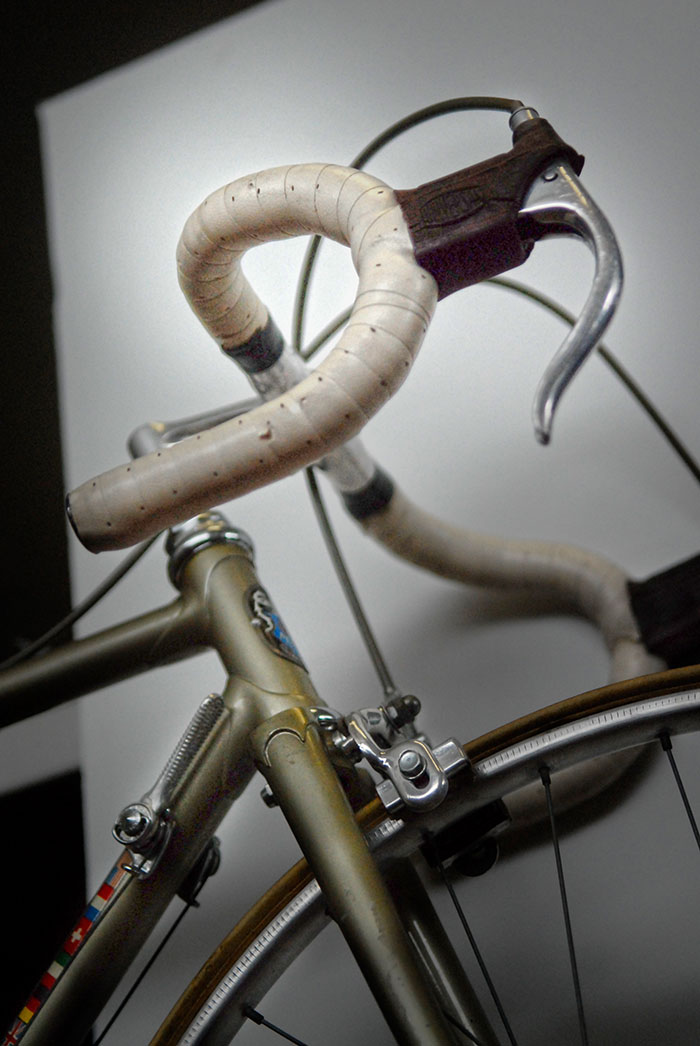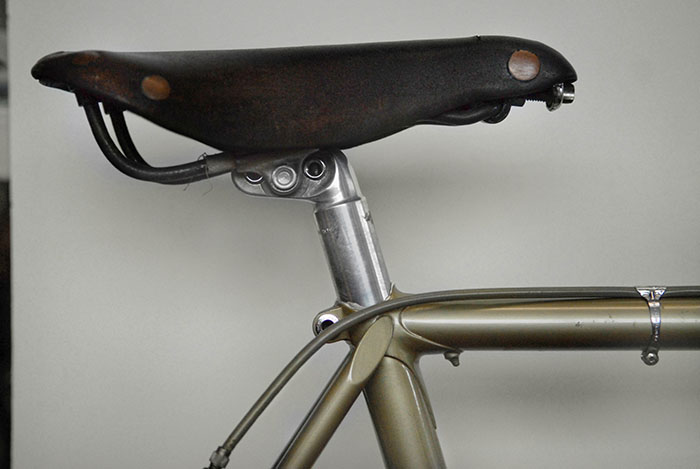Roberto Maspes was one very lucky bike racing kid. Roberto's dad Antonio Maspes established himself as a mid twentieth century Italian track cycling powerhouse, known for his prowess as a sprinter. Maspes won seven world sprint championships between 1955 and 1964, including the world championship of 1962, won on his home track the ever enduring Velodromo Vigorelli. Around the time when Antonio Maspes won his world championship in Milano, Maspes commissioned the building of probably the most exclusive junior bike ever made. Roberto Maspes' junior bike has the distinction of being one of only a handful of junior road racing bikes built by Faliero Masi. The collaboration between Masi and Maspes ran deep, Masi built Maspes' race bikes. The Masi business has always been located beneath the Vigorelli velodrome and this track was where Maspes honed his skills as a sprinter. With bonds as strong as these Faliero Masi made an easy exception and slotted in the production of the Maspes Masi Special Junior bike.
Being a living legend has it's benefits, in honour of Antonio Maspes, Campagnolo were involved in the production of exclusive equipment for this junior Masi Special. A production run of one crankset only was the result of Campagnolo's contribution to the Roberto Maspes junior road bike project. The special Campagnolo crank arms were shortened to a length of 145 mm. Campagnolo customised the Maspes cranks with a bolt circle diameter of 135 mm to incorporate smaller chainrings. At that time in the early 1960's the standard Campagnolo bolt circle diameter was a full 16 mm larger at 151 BCD. With smaller chainrings the proportion would now be more aesthetically pleasing for a twenty four inch junior road racing bike, and more easily provide correct gear ratios. Custom chainrings were also manufactured to fit the smaller bolt circle diameter. Campagnolo would not make another set of 135 BCD cranks until C-Record cranksets rolled off the production line in the mid 1980's.
For a lot of kids racing bicycles in the 1960's, a custom made Campagnolo equipped junior road bike would be out of the question. Let alone a hand built Masi with the latest Campagnolo equipment and a special one off crankset made exclusively by Campagnolo for one rider. In the early 1970's, Antonio Maspes took the Masi Special back to Faliero Masi and gave the bike a more modern update. The frame was repainted and Gran Criterium decals were used instead of the original Masi Special decals. Gear shift lever braze ons were added and the clamp on Campagnolo shift levers replaced. The Masi Milano head badge from the 1960's was left intact, denoting clearly that this bike was originally a Masi Special.
I asked Greg Softley, the current custodian of the Maspes Junior Special what he thought about the repaint. Greg said that at the time when he acquired the bike he had an option to purchase other original Maspes owned, Masi built bikes, but wasn't interested in them because Maspes preferred to refurbish his bikes over time, thus losing their original patina. The story behind the junior bike was too powerful for Greg to ignore and enough to overlook the early 1970's repaint and adjustments.
When Antonio Maspes passed away in 2000 the Vigorelli velodrome where he had trained and raced was renamed in his honour, a dedication made by the Milan City Council, the track is now known as the Velodromo Maspes-Vigorelli. Throughout it's history the track at Via Arona 19, Milano, has also been fervently referred to as Pista Magica or sometimes simply "Vigo". For many years now the fate of the Velodromo Maspes-Vigorelli has hung in the balance. In recent years various local interest groups banded together and formed the Comitato Velodromo Vigorelli with an interest in saving the world renowned track from oblivion. In May 2015 for the first time in fourteen years a bicycle race was held there, Vigo-Cross a cyclo cross race. Faliero Masi's son Alberto Masi is still connected with the Velodromo Maspes-Vigorelli.
Many velodromes do not survive the ups and downs of finding enough money to stay afloat, ravages of time and weather, war, social and political change. Velodromo Maspes-Vigorelli is no different, the track was bombed in World War Two then rebuilt after the war. Rooves collapsed in snow storms, it's Swedish pine boards left to the weather, at one point in time decayed and rotted then repaired. More recently the same council that named the track in honour of Antonio Maspes, wanted it torn down.
The story of the Roberto Maspes - Masi Special provides a historic connection to the heyday of one of the most famous board tracks in the history of cycling. Thanks to the modern wave of enthusiasm for bikes Chaingang Rotafixa, and other interest groups the Veloclub Turbolento, Gruppo Rivogliamo Vigorelli, and Sport Club Genova 1913, this famous Milan track with it's rich history will continue to be used and remembered.
Greg said, “This is obviously made by Faliero Masi, the bike was built for the son of Antonio Maspes. Maspes was an Italian track hero of the 1960’s and 1970’s. Antonio Maspes had a son Roberto that he wanted a bike built for, so Faliero built a smaller twenty four inch bike for Roberto Maspes. The Maspes-Vigorelli was Maspes' home velodrome and Masi were located at the velodrome as well.
Faliero only ever built a couple of junior bikes, that was in the early 1960’s. At that time Campagnolo strada cranks were 151 BCD, it wasn’t until 1967 that Campagnolo started producing 144 BCD cranks. Obviously a 151 BCD crankset would have looked wrong on a junior bike, out of proportion and too large. So in honour of Antonio Maspes, Campagnolo produced a set of 135 BCD cranks, one only crankset with a 145 mm crank arm. You will never find another one anywhere else. Of course when the Campagnolo C-Record groupset was released in the mid 1980’s, 135 BCD became standard from then on. The spider arms and chainrings are 135 BCD. Specially made chainrings, and crankset. Tied in with the history of Maspes.
The saddle has been shortened as well, like Otussi. The bike was originally built as a Masi Special in the early sixties. In the early 1970’s they re-jigged it as a Masi Gran Criterium, they re-painted the bike, put on the braze on’s to replace the clamp on gear levers and left the Masi Special head badge on the head tube. I think they wanted to modernise the bike a bit.
The bike has only been owned by the Maspes family. Most of the Maspes bike collection had been re-furbished over the years. The idea that Faliero Masi went and broke the train of building to make this smaller frame and that Campagnolo in honour of Maspes would produce a one off crankset, makes this a very special bike. If it wasn’t for the builder being Masi and for Maspes it couldn’t have happened. This was Campagnolo’s contribution to the project, to produce a special crankset. Hold up a 144 or 151 next to the bike it looks massive, you can see why they produced a special crankset."
With thanks to Greg Softley for allowing me to photograph this very special Masi bicycle and for generously sharing his knowledge.
All images by Robert Cobcroft



























Concealed from the Campagnolo overlords in the 1970's, workers spirited small parts out of the factory, re-assembling them at home. Ultimately displayed for sale at a village barber shop.